
From July 8th to August 4th, 1998, truk and
Katherine traveled through various areas of central,
southern and coastal Peru, northwestern Bolivia, and northern Chile. The
following text is
taken from their diaries, with truk's writing in a normal font and Katherine's
in italics.
If you have an corrections or comments, please email
them to us [truk@truk.com].
This company contacted me in 2009 and said that they run great trips to Machu Picchu.
I can't vouch for them personally, but if you have an experience with them, good or bad, please let me hear about it.
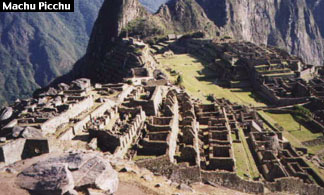 28 Julio 1998 (MACHU PICCHU and PUNO, written in AREQUIPA).
OK, so it's been twelve days since I last wrote anything in this journal.
We've been a little busy, and I just didn't feel like stopping long enough
to do it. A summary thus far:
28 Julio 1998 (MACHU PICCHU and PUNO, written in AREQUIPA).
OK, so it's been twelve days since I last wrote anything in this journal.
We've been a little busy, and I just didn't feel like stopping long enough
to do it. A summary thus far:
Machu Picchu was pretty good. After all the trouble we went through trying
to get there, buy the ticket to Quillabamba, and everything else, the Machu
Picchu site itself was definitely worth it. We headed up to the ruins about
8:30 in the morning, before the tourist mob showed up, and surveyed the
surroundings. Extremely impressive. The bus ride up was thrilling, and the
ride down was rather funny, with a little local boy trying to beat the bus
down the mountain by running (he won). Every time he saw the bus, he yelled
"Good-bye" in English or something close to that. Once up there,
I realized that all of the pictures of the ruins weren't all that
impressive after all. Given their beauty and the abundance of light, you
have to be a moron not to get good 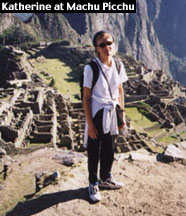 prints at this place. The whole
scene, comprised of amazing terraces and high Inca walls, filled you with
a sense of wonder, a feeling that I have come to sense again and again in
this country: "How the hell did they do that?"
prints at this place. The whole
scene, comprised of amazing terraces and high Inca walls, filled you with
a sense of wonder, a feeling that I have come to sense again and again in
this country: "How the hell did they do that?"
Aqua Calientes en route to Machu Picchu is a sort of traveler's purgatory. The party in the plaza continued well on into the might. Stacy and I got up at 6:30 to head up to Machu-Picchu. by the time we caught a bus and rode, we arrived at the gate about 8:15 or so. We were lucky because there were only a few people in line ahead of us. Later in the day, the line wound around and was long and hot. Morning at the ruins was mostly peaceful (although there was at least one bus load of tourists already there). The Incan city is laid out in such a way that the Northern half tends to be agricultural steppes and high ritual areas, while the southern end/side tends to be agricultural steppes and domestic residences.
The size of the structures is pretty amazing - the existing excavated walls range from four feet in height to easily ten feet. The lines of the rows, the heights of the walls and the angles of the roofs makes the places interesting to the eyes. Walking through the numerous structures , you can imagine people inhabiting the area - bathing, raising corps, burying their dead and worshiping the Sun God. It is an old place with the aura of old wounds and spirits. The walks were steep - many stairs. The whole city is kind of oval shaped with agricultural steppes on every side and sometimes in between.
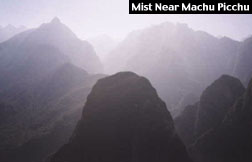 Unlike at other ruins in the Andes, at Machu
Picchu the Incas tried to use the mountainous rock in its natural form.
If there was a huge boulder jutting out of the earth, they built their stones
to find around it. There is also a cemetery on the grounds. Archaeologists
excavated about 400 skeletons from there when Machu Picchu was unearthed.
No one is sure why the Spanish never tore down Machu Picchu, nor why the
Incas didn't use it as a fortress and hide from the Spanish up there. One
theory is that the Spanish knew about the place, but since it was far away
from Cuzco and there was no gold there, they decided not to waste their
energy. Some also suspect that Machu Picchu was only inhabited during ceremonial
cycles, rather than permanently and therefore the Incas didn't see it as
an appropriate place to reside full time. The last escaping Inca leader
is said to have knowingly taken a lower road, intentionally away from Machu
Picchu, out of the Andes to escape the Spanish. There are no records of
why no other Incas retreated to Machu Picchu - maybe they were killed before
they could return. Maybe they were coerced to go "quietly" into
colonial life, who knows?
Unlike at other ruins in the Andes, at Machu
Picchu the Incas tried to use the mountainous rock in its natural form.
If there was a huge boulder jutting out of the earth, they built their stones
to find around it. There is also a cemetery on the grounds. Archaeologists
excavated about 400 skeletons from there when Machu Picchu was unearthed.
No one is sure why the Spanish never tore down Machu Picchu, nor why the
Incas didn't use it as a fortress and hide from the Spanish up there. One
theory is that the Spanish knew about the place, but since it was far away
from Cuzco and there was no gold there, they decided not to waste their
energy. Some also suspect that Machu Picchu was only inhabited during ceremonial
cycles, rather than permanently and therefore the Incas didn't see it as
an appropriate place to reside full time. The last escaping Inca leader
is said to have knowingly taken a lower road, intentionally away from Machu
Picchu, out of the Andes to escape the Spanish. There are no records of
why no other Incas retreated to Machu Picchu - maybe they were killed before
they could return. Maybe they were coerced to go "quietly" into
colonial life, who knows?
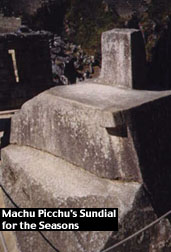 We left the ruins about 12:30.
By then, it was very crowded and there was a line to get into the gate.
The line for train tickets began forming around 1:30. In Aguas Calientes,
Stacy left me at Inca Pizzeria on Plaza de Armas and went to wait in line.
We did get tickets for the 4:30 local train (which didn't leave until after
5:15). Before the train arrived and departed, we were able to get a free
shower out of Gringo Bill. From there we gathered up our stuff and sat near
the tracks across from all of the Aguas Calientes "river side"
restaurants. The train ride home was interminable. We sat across from half
a family (father and son) from Michigan who were on a 14 day tour of the
area. They had met up with their daughter/sister who had been studying Spanish
in Argentina for the last six months. They had hiked the Incan trail, gone
rafting on the Urubamba River and were headed to La Paz and Lake Titicaca
too. The train was so full that many people stood the 5 hours ride rather
than wait in Aguas Calientes for the night - I don't blame them...
We left the ruins about 12:30.
By then, it was very crowded and there was a line to get into the gate.
The line for train tickets began forming around 1:30. In Aguas Calientes,
Stacy left me at Inca Pizzeria on Plaza de Armas and went to wait in line.
We did get tickets for the 4:30 local train (which didn't leave until after
5:15). Before the train arrived and departed, we were able to get a free
shower out of Gringo Bill. From there we gathered up our stuff and sat near
the tracks across from all of the Aguas Calientes "river side"
restaurants. The train ride home was interminable. We sat across from half
a family (father and son) from Michigan who were on a 14 day tour of the
area. They had met up with their daughter/sister who had been studying Spanish
in Argentina for the last six months. They had hiked the Incan trail, gone
rafting on the Urubamba River and were headed to La Paz and Lake Titicaca
too. The train was so full that many people stood the 5 hours ride rather
than wait in Aguas Calientes for the night - I don't blame them...
We got back down to Aquas Calientes, ate, and went up to buy a ticket back to Cuzco (fourth in line this time). Got our local ticket and made it back to Cuzco late on the 17th. We stayed in the same hostel, in the same room, in Cuzco as before. It was as though we never left. At 6:30 am, we found ourselves at the other train station trying to get to Puno. The bolleteria (ticket window) was out of Pullman and everything else, save 1st and 2nd Class. We secured two 1st Class tickets on the 8 am train. We sat across from two kind ladies from Warsaw, Poland, Alicja and Dorota, with a Polish Lonely Planet. The ride was extremely crowded and bumpy, with cholitas (the local, traditional women) in every aisle. Once, one of them got up out of the aisle, threw her blanket-wrapped package (the same one she had been sitting on) down on our table, opened the package, grabbed a hunk of some sort of animal rib with meat on it, and started hacking away at it with a machete/knife, right in front of me. The meat smelled incredibly bad, and Kath, Alicia, and Dorota were laughing their heads off at this scene. A Canadian guy behind us got a picture of the whole thing and said he would send it to us.
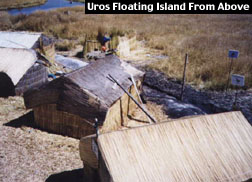 At Puno, we found a decent hotel and went out for some
food at this place called the International. Good grub, but we never made
it back there. The next day, the 19th, we slept in and went down to the
docks to see the Uros people who are famous for their floating islands of
woven reeds.
At Puno, we found a decent hotel and went out for some
food at this place called the International. Good grub, but we never made
it back there. The next day, the 19th, we slept in and went down to the
docks to see the Uros people who are famous for their floating islands of
woven reeds.
For about a dollar we were driven down to the dock in a wobbly metal cage attached to a tricycle, also known as tricycle taxi service. Before we could even walk to the dock area, a man approached us about going out on a boat to see the floating islands. Stacy had been sad that we woke up late, thinking that we would not have anything to do today. 24 nuevo soles later, we were slowly motoring through the pea green algae of Lake Titicaca. The pea soup alga is thick and has a rotting smell and coats the water stalks of the reeds as the boat passes through a water path in the reeds. we stop first at the Floating island of Santa Maria. It is a small island with maybe 30 people. There is a reed bano (bathroom), a reed look-out, a reed bird coop, reed houses and most importantly, reed souvenir booths where men and women from the island sell various things including Alpaca wear, necklaces, miniature reed boats, tapestries, and more. Walking around on the island is like walking on a huge bed of pine or cedar shaving - very soft and spongy, but thick enough that you couldn't fall through.

 The life on the islands doesn't
seem too active. It's seems as though they just wait on visitors, sew tapestries,
feed the chickens, fish, take the reed boat out to get more reeds, build
reed things, and wait for more visitors to come. The island itself has been
a way of life for these people for so long that the underside of the island
has turned into a buoyant mud. Now, they use the mud as adobe to build foundations
for their reed buildings. There was even a small reed church on Santa Maria.
Next, we rode on to Uros, however there is a check point where everyone
is suppose to pay one sol to enter. We were sharing our ride with two Peruvians
and two Spaniards. The Spanish couple refused to pay for entrance into the
island since they had already paid for their share of the boat ride. The
Peruvian guys coughed up the 6 soles, neither party looked to us for an
answer or a contribution and the Spanish couple came out looking like snobs.
The life on the islands doesn't
seem too active. It's seems as though they just wait on visitors, sew tapestries,
feed the chickens, fish, take the reed boat out to get more reeds, build
reed things, and wait for more visitors to come. The island itself has been
a way of life for these people for so long that the underside of the island
has turned into a buoyant mud. Now, they use the mud as adobe to build foundations
for their reed buildings. There was even a small reed church on Santa Maria.
Next, we rode on to Uros, however there is a check point where everyone
is suppose to pay one sol to enter. We were sharing our ride with two Peruvians
and two Spaniards. The Spanish couple refused to pay for entrance into the
island since they had already paid for their share of the boat ride. The
Peruvian guys coughed up the 6 soles, neither party looked to us for an
answer or a contribution and the Spanish couple came out looking like snobs.
The Uros, always a small group of people, took to living on floating
islands before the time of the Inca. It is believed that they simply wanted
a way to avoid conflicts with groups living on land, and they continued
the practice through the Spanish conquest and even to the modern day. It
was a short ride out to where they live, through the green, vegetation-filled
part of Lake Titicaca. Soon, we came upon the reeds growing out of the lake
and then the islands themselves. The first island had a few merchants on
it selling sweaters, necklaces and the like, a school, a church, and a lookout
tower, all made of reeds. They even had a bano (bathroom) off on the side,
all floating. The ground around the island is very soft and inviting, like
a deep carpet of loose reeds. The second island 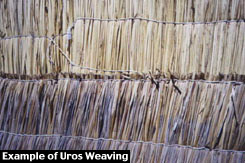 was much bigger,
with a main market area, lots of living quarters, women frying fish, kids
selling postcards, and lots of boats. The Uros seem to have largely cast
off the traditional reed boats for standard wooden boats, like those of
the Puno fisherman. I bought a sweater on the island, and Kath and I wandered
around on the main island for an hour or so. It was hard to tell what was
private space from public space.
was much bigger,
with a main market area, lots of living quarters, women frying fish, kids
selling postcards, and lots of boats. The Uros seem to have largely cast
off the traditional reed boats for standard wooden boats, like those of
the Puno fisherman. I bought a sweater on the island, and Kath and I wandered
around on the main island for an hour or so. It was hard to tell what was
private space from public space.
Uros is a larger floating island, probably 50 or more people live there. Again, there were many booths of souvenirs to choose from. Stacy bought and Alpaca sweater from one lady. We also bought some hand drawn and colored post cards from two young girls. The cards depict life on the islands - fishing and cutting reeds. We walked down one of the island's foot paths. There were rolls of thatched reeds waiting to be formed into walls of houses or fences. Children were playing and even dogs roamed the island. On one side of the island , a man was fashioning the top cover for a boat out of reed. Even though we were in the middle of the lake, standing on decomposing reeds, with water all around, things felt secure.
After coming back to Puno's docks, we wondered through the markets and
went back to the hotel. We both crashed about 6 pm that night and didn't
get up until the next day. By then, we had tracked down an Internet connection
and blew an hour there writing friends. By the time we got down to the docks,
all of the boats for Isla Taquile had already left. We were in luck, though.
We decided to check out a boat in the harbor, the 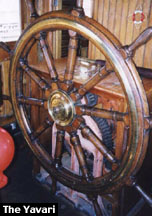 Yavari, where
we met Captain Carlos Saavedra. The captain was
kind enough to take us on a tour even though this is usually the day the
boat is closed for cleaning. Carlos was extremely proud and passionate about
sailing and the preservation and future of his ship. He is a retired Navy
man and his love of the craft and the water is obvious in his every word.
Yavari, where
we met Captain Carlos Saavedra. The captain was
kind enough to take us on a tour even though this is usually the day the
boat is closed for cleaning. Carlos was extremely proud and passionate about
sailing and the preservation and future of his ship. He is a retired Navy
man and his love of the craft and the water is obvious in his every word.
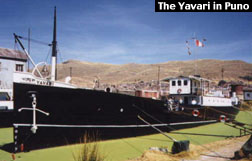 The ship was brought to the Lake via Arica, Chile, were it was brought,
disassembled, after being constructed in the UK. There, a train took it
part of the way up into the Andes, and then porters with llamas took over
and hauled it the remaining way to Puno. It took something like 6 years,
until 1870, to get it all to Puno and put together. After several years
as a cargo vessel and a few years as a Navy ship, a wealthy British woman
bought the Yavari and is trying to get her into good enough shape to carry
passengers again. The project will cost over half
a million dollars, which the owner is trying to raise, to fully restore
and make the ship passenger-ready. In the meantime, Captain Carlos and his
crew welcome visitors to sign the register (Michael Palin did) and make
a donation to the cause. The ship itself is amazing and the tour
by Carlos quite stimulating. They kept the Captain's berth for the British
owner, even though she was rarely there. Carlos lived on board. We had some
tea, made a donation, and went back to the hotel by way of the market. Later
that afternoon, we climbed to the top of Huajspata Park to get a view of
Puno and the lake. All in all, Puno is a dump but a dump we couldn't avoid.
The ship was brought to the Lake via Arica, Chile, were it was brought,
disassembled, after being constructed in the UK. There, a train took it
part of the way up into the Andes, and then porters with llamas took over
and hauled it the remaining way to Puno. It took something like 6 years,
until 1870, to get it all to Puno and put together. After several years
as a cargo vessel and a few years as a Navy ship, a wealthy British woman
bought the Yavari and is trying to get her into good enough shape to carry
passengers again. The project will cost over half
a million dollars, which the owner is trying to raise, to fully restore
and make the ship passenger-ready. In the meantime, Captain Carlos and his
crew welcome visitors to sign the register (Michael Palin did) and make
a donation to the cause. The ship itself is amazing and the tour
by Carlos quite stimulating. They kept the Captain's berth for the British
owner, even though she was rarely there. Carlos lived on board. We had some
tea, made a donation, and went back to the hotel by way of the market. Later
that afternoon, we climbed to the top of Huajspata Park to get a view of
Puno and the lake. All in all, Puno is a dump but a dump we couldn't avoid.
Lima
-> Huancayo -> Ayacucho
-> Cuzco -> Machu Picchu/Puno ->
Lake Titicaca ->
La Paz -> Arequipa
-> Colca Canyon -> Nazca/Pisco/Lima